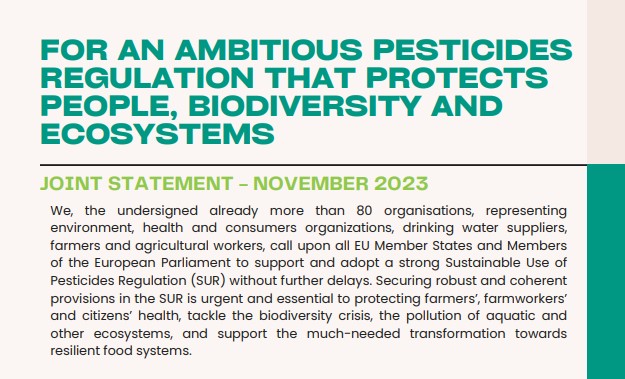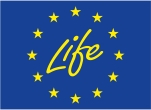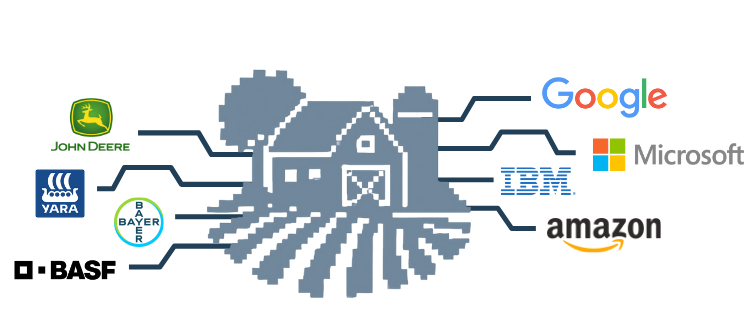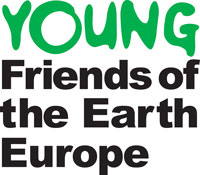
We, the undersigned already more than 75 organisations, representing environment, health and consumers organizations, drinking water suppliers, farmers and agricultural workers, call upon all EU Member States and Members of the European Parliament to support and adopt a strong Sustainable Use of Pesticides Regulation (SUR) without further delays. Securing robust and coherent provisions in the SUR is urgent and essential to protecting farmers’, farmworkers’ and citizens’ health, tackle the biodiversity crisis, the pollution of aquatic and other ecosystems, and support the much-needed transformation towards resilient food systems.
The need to significantly reduce pesticide use has been stressed by the scientific community, and repeatedly called for by EU citizens. Less than a year before the 2024 EU elections, people across the EU expect from decision-makers to better protect their health and nature.
IPM has been a legal requirement for farmers since 2014 (Directive 2009/128/EC), but implementation has failed. The SUR Regulation is essential to address the weaknesses of the 2009 Directive on the Sustainable Use of Pesticides and ensure that all EU Member States play their part in ensuring a sustainable future for farmers, citizens and the environment. For the SUR to deliver on health and environmental protection, we specifically ask you to support the following ten priority demands (seealso the Annex for further details):
1. Support binding EU and national reduction targets
to reduce by at least 50% the use and risk of chemical pesticides by 2030, and to reduce by 100% the use of more hazardous pesticides by 2030. More than 1 million citizens across Europe call for phasing out the use of synthetic pesticides by 80% until 2030, starting with the most hazardous, to become 100% free of synthetic pesticides by 2035. The binding reduction targets should be set also for wholesalers and retailers, to make sure the whole food chain is engaged and contributes to reaching the pesticide reduction goals.
2. Support and preserve binding and ambitious implementation of IPM and crop-specific rules
This requires setting a clear definition of hierarchical Integrated Pest Management (IPM) steps from general agroecological practices to more crop-specific protection methods, with chemical pesticides being used as a very last resort. IPM should be applied on 100% of utilised agricultural area. Effective and enforceable IPM crop- specific rules have to be in place for at least 90% of the utilised agricultural area. A clear, directly nationally binding framework is a prerequisite for the SUR to lead to effective changes in agricultural practices, and decrease pesticide dependency.
3. Replace the Harmonised Risk Indicator 1
which is highly unfit for purpose, and strengthen monitoring and reporting requirements. It is essential that the used indicators allow for a realistic and correct evaluation of the reduction of pesticide use and risk over time. At the same time, regular public reporting of pesticide usage – crop and regional-specific – as well as mandatory monitoring of pesticides and their impact in/on different matrices (soil, water, air, biodiversity, indoor dust, humans) should be included in the SUR, using science-based and robust monitoring indices.
4. Ban pesticide use in sensitive areas, to protect human health, the environment & ecosystems
By way of derogation, in case all non- chemical IPM measures have failed and the economic threshold for crop damage is exceeded, low-risk non-synthetic and low-risk biocontrol substances could be allowed in agricultural areas located in sensitive areas (not outside agricultural areas). Within these boundaries, low-input nature- inclusive systems, including organic agriculture, agroecology and agroforestry, can be stimulated in agricultural areas. Sensitive areas should include at least the areas listed in the Annex of this statement.
5. Establish effective cultivated or uncultivated buffer zones around sensitive areas
to protect citizens and biodiversity, with widths as wide as needed to effectively protect citizens and biodiversity, and of minimally 100 m. Cultivated or uncultivated buffers must also be established around all waterways, houses and gardens. Research shows that pesticides are found at very far distances from where they are applied, on children’s playgrounds, in indoor dust and nature areas. For example, research shows that the number of pesticide residues in insects in nature areas is related to the proportion of agricultural production in a radius of 2,000 m. Measures, in the form of bufferstrips, need to be taken to also effectively protect untreated fields and pastures and organic fields from contamination with (other) pesticides.
6. Ensure coherence in the SUR, so that funds under the EU’s CAP are used to support farmers in reducing pesticide use
and to contribute to the preservation and restoration of ecosystem functioning and the regeneration of rural areas. The public funds of the Common Agricultural Policy (CAP) should be distributed in a fair way, supporting common goods and agricultural practices which reduce pesticides, protect citizens’ health, preserve and restore the environment, while sustainably providing food. Member States can update their national strategic plans every year and make changes in their allocation of funds to align with SUR objectives. SUR obligations need to be reinforced in the specific objectives of the post-2027 CAP and in the conditionality of the CAP Strategic Plans regulation post-2027 (Regulation (EU) 2021/2115). Specifically IPM, crop-specific rules and reduction targets should be part of the conditionality in the post 2027 CAP.
7. Ensure that truly independent advisory services are available to support farmers in reducing pesticide use.
The pesticide industry should be prohibited from providing any kind of advisory services to farmers.
8. Ensure strong provisions on occupational and non-occupational health and safety duties by employers.
Introduce sanctions for employers not respecting IPM rules and the reduction targets, and an obligation to provide training on pesticide use to workers during paid working time. Ensure that information is publicly available on pesticide legislation, the potential risks for health and safety linked to the exposure to all used pesticides, and on procedures to report diseases linked to the use of pesticides. Ensure that agricultural workers and citizens can access official documentation reporting the type of pesticides used during their work activity/used in their surroundings to get (occupational) diseases properly recognised in cases of diseases linked to pesticide exposure.
9. Implement Extended Producer Responsibility.
In addition, introduce a risk-based EU-wide pesticide levy, in a progressive way, and tailored to the toxicity level of pesticides, to finally implement the polluter pays principle. The costs of pesticide impacts are a huge burden to society and should no longer be borne only by people, water companies and farmers using no or minimal amounts of pesticides. Extended Producer Responsibility and a pesticide levy is a first step to internalising the true cost of the use of pesticides, and can contribute to funding for the environmental costs of pesticide use, indemnifying those suffering the collateral damages from the use of pesticides and supporting farmers in the transition to sustainable practices.
10. Include the precautionary principle
As in the Directive 2009/128/EC and Regulation EC no 1107/2009, and set out in Article 191 of the EU Treaty. EU pesticide
legislation states that the objective of protecting human and animal health and the environment should take priority over the objective of improving plant production. Therefore, in case of scientific uncertainty regarding risks, the precautionary principle should be applied. This principle should remain key in the SUR, and should also ensure that Member States further restrict or prohibit the use of pesticides in specific circumstances or areas.
We count on you to stand firmly for a more resilient food system and implement the pesticide reduction objectives of the Farm to Fork and Biodiversity Strategies for the benefit of citizens, farmers, biodiversity and agricultural areas across the EU.
The list of signatories and the Annex are displayed here.

This publication is co-funded by the European Union. Views and opinions expressed are however those of the author(s) only and do not necessarily reflect those of the European Union or CINEA. Neither the European Union nor the granting authority can be held responsible for them







